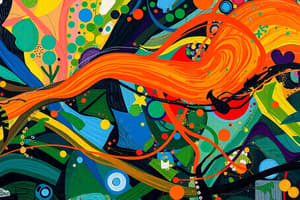Podcast
Questions and Answers
What is the primary source of energy for all life on Earth?
What is the primary source of energy for all life on Earth?
- Thermal energy from the Earth's core
- Chemical reactions in the ocean
- The Sun (correct)
- Geothermal energy from volcanoes
Which of the following best describes the 10% rule in ecology?
Which of the following best describes the 10% rule in ecology?
- 10% of an organism's energy is consumed by its predator
- 10% of energy is lost at each trophic level (correct)
- 10% of species in an ecosystem represent the majority of biomass
- 10% of sunlight is converted into chemical energy
Eutrophication is primarily caused by which of the following?
Eutrophication is primarily caused by which of the following?
- Overfishing of aquatic species
- Reduction of sunlight penetration in water
- Increased nutrient runoff into water bodies (correct)
- Decrease in water temperature
What is the function of ATP in cellular processes?
What is the function of ATP in cellular processes?
Which of the following factors can significantly affect enzyme activity?
Which of the following factors can significantly affect enzyme activity?
Flashcards
Photosynthesis
Photosynthesis
The process by which plants and some bacteria convert light energy into chemical energy (glucose) using carbon dioxide and water.
Cellular Respiration
Cellular Respiration
The breakdown of glucose in the presence of oxygen to release energy (ATP) and produce carbon dioxide and water.
Allopatric Speciation
Allopatric Speciation
The process of a population evolving into two or more distinct species due to geographical isolation.
Punctuated Equilibrium
Punctuated Equilibrium
The theory that evolution occurs in short bursts of rapid change followed by long periods of stability.
Signup and view all the flashcards
Natural Selection
Natural Selection
The process where organisms with traits better suited to their environment are more likely to survive and reproduce, passing on those traits.
Signup and view all the flashcardsStudy Notes
Unit A: Energy and Matter Exchange in the Biosphere
- Energy source for Earth: The source of all energy on Earth is from the sun.
- Biosphere organization: Biosphere organization includes species, populations, communities and ecosystems.
- Energy pyramids: The 10% rule describes how energy transfers in an ecosystem, with 10% being transferred to the next trophic level.
- Laws of thermodynamics: The laws of thermodynamics govern energy transformations in the biosphere.
- Food chains/webs: Food chains and food webs represent the flow of energy and nutrients through an ecosystem.
- Nutrient cycles (hydrological, carbon, nitrogen, phosphorus): These cycles are essential for maintaining biosphere balance.
- Photosynthesis and chemosynthesis: These processes are crucial for energy production in different ecosystems.
Unit B: Ecosystems and Population Change
- Eutrophication: A process where excess nutrients in a water body lead to algal blooms and oxygen depletion.
- Deforestation and forest fires: These events drastically impact ecosystem structure.
- Biomes: Different types of ecosystems characterized by specific climate, flora and fauna.
- Scientific names & classification: Organisms are classified using a hierarchical system.
- Natural selection/inherited characteristics: Traits are passed down through generations and influenced by environment.
- Mutations: Changes in genetic material can create new characteristics.
- Gradualism/punctuated equilibrium: Models explaining the rate of evolutionary change.
- Allopatric speciation: A type of speciation where two species arise due to geographical isolation.
- Evidence of evolution: Supports evolutionary theory through fossil records, DNA, and other mechanisms.
Unit C: Photosynthesis and Cellular Respiration
- Photosynthesis/cellular respiration: Processes occurring within organisms for energy production.
- ATP: The primary energy currency used by cells in metabolic processes.
Unit D: Human Systems
- Digestive system enzymes: Enzymes play critical roles in the breakdown of food in digestion.
- Enzyme activity factors: Factors influencing the speed and efficiency of enzyme-catalyzed reactions.
- Inhalation/exhalation: The process of breathing, including the mechanics and functions.
- Respiratory disorders: Diseases and conditions affecting the respiratory system.
- Blood oxygenation/deoxygenation: Where in the body blood is oxygenated and deoxygenated.
- Muscle types/blood vessel types, blood cell types: Different types of muscles, blood vessels, and blood cells and their function.
- Sliding filament theory: A model explaining muscle contraction.
- Thermoregulation: Mechanisms used by the body to maintain stable internal temperature.
- Blood flow/transfusion: Transports blood through body, processes involving blood transfusions.
- Immune response/Lymphatic system: The body's defense mechanisms against disease and immune system processes.
- Excretory system: Structures related to the removal of metabolic wastes, includes the process and urinary system.
Studying That Suits You
Use AI to generate personalized quizzes and flashcards to suit your learning preferences.



